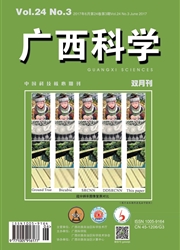

 中文摘要:
中文摘要:
【背景】A型流感病毒的M2质子通道蛋白的X-ray和NMR结构已于2008年测定,并成为发展抗流感的重要药物靶标,但学术界对于抑制剂的作用机理尚有争论。【方法】用SYBYL软件作M2通道蛋白与金刚烷胺抑制剂的对接计算,在可能的对接位点(Asp-44,Trp-41,His-37)上用精确的量子化学方法计算对接能,并根据结构化学和物理化学的原理分析抑制剂的作用机理。【结果】计算了金刚烷胺与M2质子通道的多个可能的结合位点的结合能,包括His-37,Trp-41和Asp-44。【结论】金刚烷胺对M2的抑制是一个动态过程,可能有多个位点结合。金刚烷胺穿透细胞膜后在通道出口与Asp-44形成盐桥,质子流使盐桥解离,金刚烷胺再进入通道与芳香氨基酸Trp一41(或His一37)形成阳离子一兀键。
 英文摘要:
英文摘要:
Background]The structure of M2 proton channel in influenza A virus has been solved in 2008 by using X-ray and NMR,which is a drug-target for inhibitor design.Howev-er,so far the inhibition mechanism is not very clear.[Methods]The possible binding sites of amantadine in M2 channel are determined by using docking calculations.Then the binding energies are calculated by using higher level quantum cheical calculations.[Results]The accu-rate binding energies at the sites His-37,Trp-41,and Asp-44 are calculated.[Conclusion]This inhibition of amantadine to M2 channel is a dynamic procedure.After the amantadine pene-trates the cell membrane it binds at the Asp-44 through salt-bridge interaction.The salt-bridge may be broken in the proton flow,then amantadine comes in the channel,and binds at the aromatic amino acid Trp-41 (or His-37)with the cation-πinteraction.
 同期刊论文项目
同期刊论文项目
 同项目期刊论文
同项目期刊论文
 期刊信息
期刊信息
